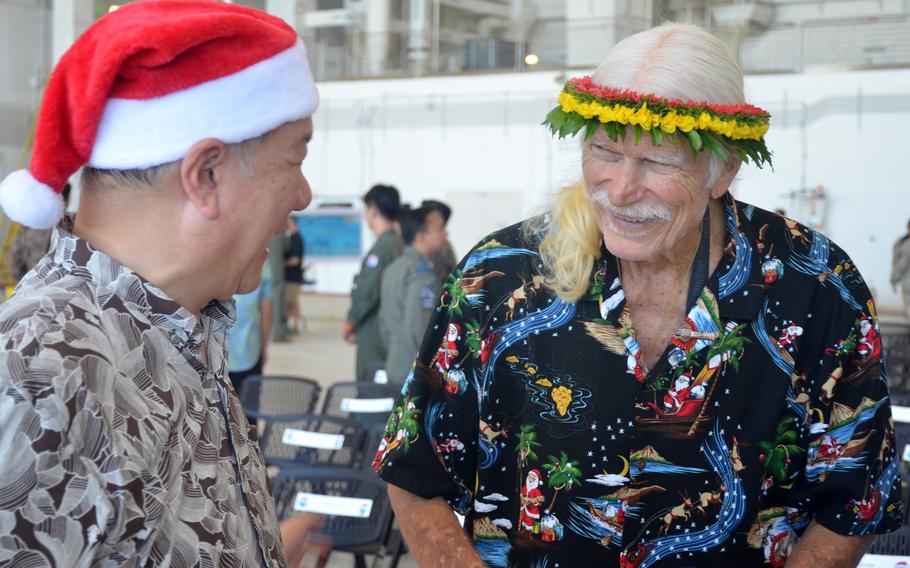
Susumu Ueda, the consulate-general of Japan on Guam, left, and Bruce "Brother Bruce" Best, a communications specialist, discuss Operation Christmas Drop at Andersen Air Force Base, Guam, Dec. 9, 2024. (Alex Wilson/Stars and Stripes)
ANDERSEN AIR FORCE BASE, Guam — Massive military transport aircraft took to the skies over the weekend as the U.S. Air Force set in motion the Defense Department’s longest-running humanitarian mission for the 73rd year.
The aircraft — predominantly C-130J Super Hercules from Yokota Air Base, Japan — took with them crates filled to the brim with food, camping gear, medical equipment, toys and other supplies to be dropped to remote islands as part of Operation Christmas Drop.
Sunday’s drops, spread across six sorties, covered thousands of miles and delivered the packages to far flung islands, including Palau and Kapingamarangi, an atoll in the Federated States of Micronesia.
Additional sorties will continue until the operation concludes Dec. 16.
To celebrate the start, hundreds gathered Monday at Andersen’s Hangar 2 for the annual Christmas Drop “push ceremony,” which traditionally includes key speakers loading one of the crates onto an aircraft.
“We had a great set of drops; we did not crush the beach huts, and we had not lost boxes. That’s a good day in our book,” Bruce Best, a Guam-based telecommunications expert who has assisted in the operation for decades, said during the ceremony.
Last year’s Operation Christmas Drop saw 210 packages delivered to 60 remote islands in the South Pacific. This year is bigger than ever with at least 220 packages set to be delivered to 60 islands, according to Col. Richard McElhaney, commander of Yokota’s 374th Airlift Wing.
The operation also has at least four active partners — Australia, Canada, Japan and South Korea — and the Philippine air force may also join later in the operation, wing spokeswoman Capt. Emma Quirk said by email Monday.
The 374th is scheduled to fly 36 sorties, while partner nations will fly a combined 42 sorties.
An additional 14 observer nations are participating this year, Quirk said.
While the humanitarian side of the mission is by far the most important aspect of Christmas Drop, it also provides a unique training opportunity.
“The training challenges out here are the remote island destinations, and the things we do in the aircraft — we have to do some distribution planning and whatnot. That’s a fantastic test for some of our younger aviators,” McElhaney told reporters before Monday’s ceremony.
It also builds relationships and fosters cooperation between the partner and observer nations.
“I think if we could reach more people, it’s fantastic,” McElhaney said. “I think the growth potential is great.”